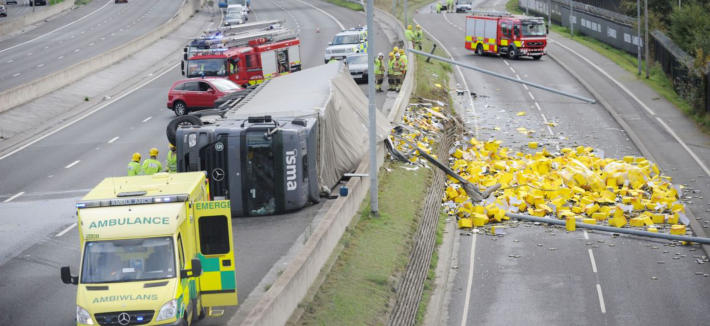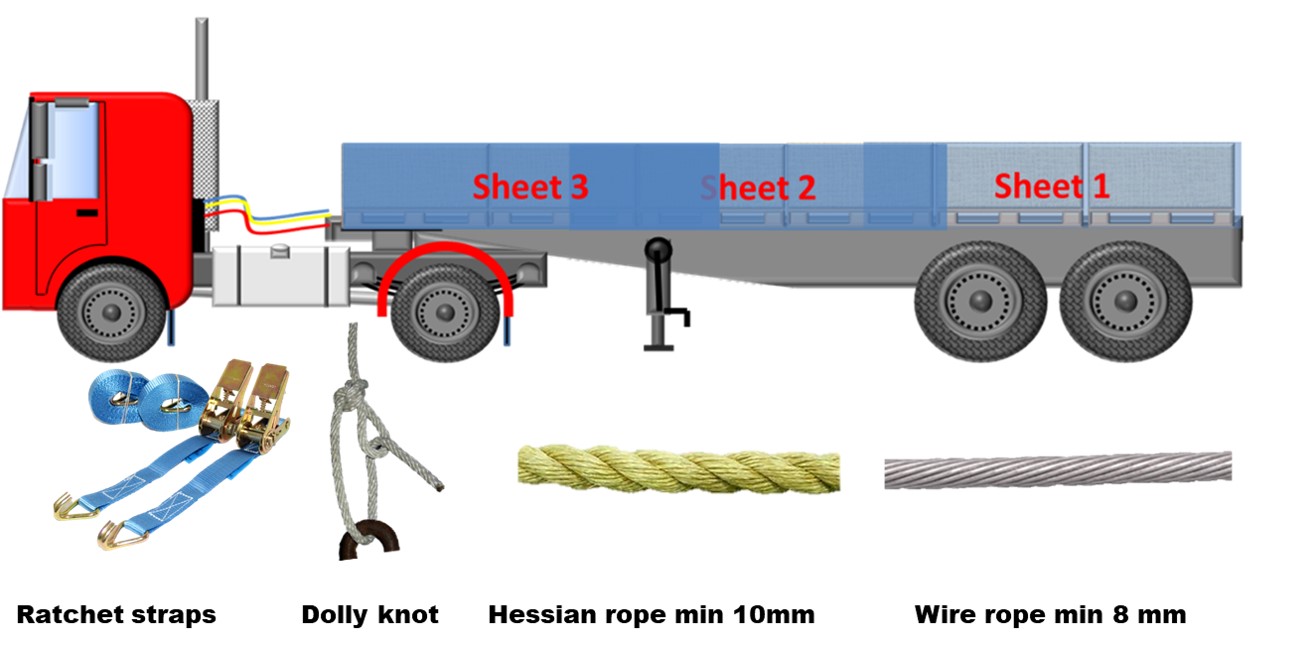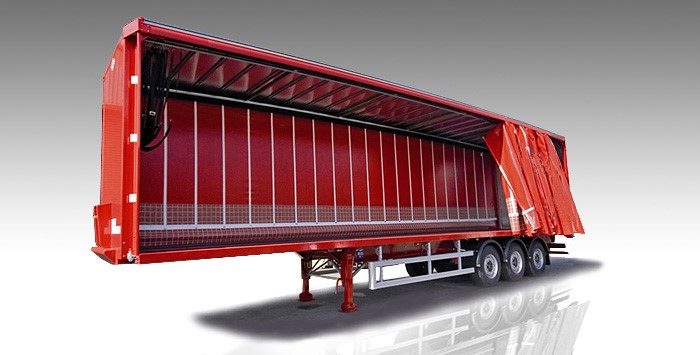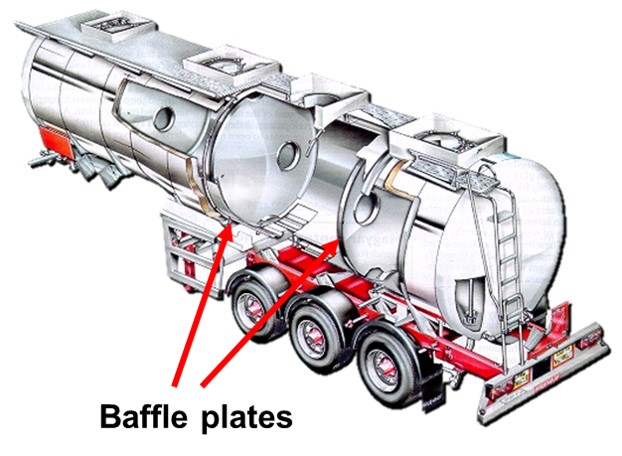VEHICLES & LOADING
Box vehicles
Box vehicles are generally loaded and offloaded through the back door. It is important that you check the load has been distributed evenly. If you have any doubts about the weight, take the vehicle to a public weigh-bridge to check the load. Remember it is the driver’s responsibility.
Make sure that the load cannot move whilst in transit. Secure the load with ratchet straps if necessary. If the load does move it can reduce the stability of the vehicle and affect the handling.
Flat beds
A flatbed platform is one of the most common ways to transport goods as it can be used for a variety of loads. Again it is important to distribute the load evenly, making sure that the MAM has not been exceeded and that all axle weights are correct. It is the driver’s responsibility to make sure that the load reaches its destination in a good condition. The problem with a flat bed platform is that the load is open to the elements.
Using ratchet straps and ropes may not keep the load from getting damaged by the
elements; you must cover the load with sheets. If you have a small platform body one sheet may cover the load, if your vehicle is long then you may
need to use several sheets. If you do have to use multiple sheets always start with the rear sheet, then overlap them until the entire load is covered.
This will stop wind and rain getting under the sheets causing damage. If you have more than one destination it will also allow you to just remove the sheets as and when you drop parts of the load off.
Ratchet straps are the best form of restraint. If you have to use hessian ropes they must be at least 10 mm thick. To get the correct tension on ropes you will have to learn how to form the drivers hitch (Dolly Knot). Depending on the load you can also use wire rope; this must be at least 8 mm thick.
Flat-beds are also used for transporting tubular steel and for this you must use the correct steel link chains and ratchets. This will stop the tubes from moving. Chains you must not use are split link chains and iron chains, always use steel chains as other chains are less reliable. Never use rope or wire on tubular steel.
Hiab
When loading and unloading heavy items with a crane fitted to your vehicle and you feel the ropes or straps may break, always use chains and tensioners. If you are loading or unloading your vehicle with a lorry mounted crane, you must also extend the safety arms and feet to give you greater stability so the vehicle does not topple over.
Curtain Sided
Curtain sided vehicles or trailers are a much more convenient way of transporting goods, they are a flat bed vehicle with a roof and front and back panels. The sides have curtains, allowing the driver to open and close them to load or un-load the vehicle.
These vehicles are quite high which causes problems in windy weather when empty, the sides act very much like a parachute. If you find yourself in this situation, open the curtains and secure them to the front or rear of the platform.
This will allow the wind to pass through whilst maintaining the vehicles stability. Inside the vehicle there is normally ratchet straps attached to the roof allowing you to secure the load. Do not rely on the curtains to restrain the load.
There are specially constructed curtain sided vehicles with two decks. Make sure that if you have to drive with only the top deck loaded, you drive extremely carefully as the vehicle will be top heavy and you could loose control and topple over.
Refrigerated trucks
Refrigerated bodies are enclosed to maintain a steady temperature and will always be loaded through the rear doors. You must make sure that the temperature is regulated and that there is enough fuel in the fridges auxiliary tank to keep the fridges running at the correct temperature. Remember you are responsible for the load reaching its destination in good condition. Animal carcases will generally hang down from the roof, the effects of driving too fast or braking on a bend can cause the carcases to swing.
This will transfer weight aggressively from one side to the other causing your vehicle to become unstable. This is known as the pendulum effect, the weight transfer could result in your vehicle over turning.
When driving a refrigerated truck, drivers must have completed the relevant food hygiene courses.
Dis-mountable bodies
Dis-mountable bodies offer the haulage company the ability to use their vehicles for a variety of uses. The lorry does not have a permanent platform, but it has a locking system that allows the vehicle to load a variety of different bodies. It allows the haulier to load units in preparation for the next delivery instead of waiting for a driver to return with an empty vehicle.
All the driver has to do is lower the legs on the empty box and drive out from under it then reverse under the next loaded one. Dis-mountable bodies also give the ability to change from box units to tankers. Make sure that the body is locked to the vehicle and the legs have been raised before driving away.
It is very important with all loads, whether flat-bed, curtain sided, box or dis-mountable that you secure them correctly, as the loads can move. Braking and steering excessively could possibly result in the loss of the vehicle load , this is called shedding.
 No matter what type of load you have, always brake gently whilst travelling in a straight line.
No matter what type of load you have, always brake gently whilst travelling in a straight line.
ISO Containers (International Standard Organisation)
The ISO container is used throughout the world to import and export goods. Drivers in the UK can, at times, be required to collect and deliver the sealed containers. When collecting these containers you must have the correct vehicle body.
If you are collecting an ISO container your vehicle body must be equipped with
twist locks. These locks are easy to operate and it is important to make sure that
they are locked at all times.
The containers come in 2 sizes: 20 foot and 40 foot. You could possibly, depending on the length of your vehicle, collect 2 x 20 foot containers for distribution. These containers have probably not been loaded in line with UK weight regulations. It is therefore, important that your vehicle is weighed before leaving the port, making sure that you are within your MAM.
If you find yourself being part-loaded with a 20 foot container, you must always position this over the rear wheels of the trailer. This will improve traction and stability and reduce vehicle bounce.
Tankers
Food tankers are used to transport ingredients to food manufacturers. Unloading these vehicles is done by pressurising the tank, you will need specialist training to do this. Loading these tankers is done through the top hatches; you must take extra care when carrying out the loading of this type of vehicle.
The walkways on the top of the tank are made of metal and can be very slippery, you must also be aware of overhead cables as you might end up hanging yourself, it’s a long way to fall.
Fuel tankers are different to food tankers. With fuel tankers the load will move, it’s called the wave effect. Liquid is a heavy commodity, your tanker will probably be only half full when your MAM is achieved. This will allow the fluids to swish about in the tank, when braking the liquid will move to the front of the tanker just like a wave. It is important that you do not release the foot-brake until you have applied the parking brake as the wave effect can push you forward.
Fluid Tankers are generally fitted with baffle plates, baffle plates are large plates in the body of the tanker that limit the wave effect but allow the tanker to be loaded and emptied.
When driving a C+E with a tanker, there are two types of trailer, those fitted with two axles (tandem) and those fitted with three axles (Tri-axle). Tri-axle trailers are fitted with single slightly wider wheels.
This allows the tank to sit lower down and closer to the chassis, greatly improving the vehicles stability. Braking on a bend can cause the liquid to move from side to side causing the wheels on one side to loose contact (rear wheel lift) with the road. Aggressive driving can turn rear wheel lift into vehicle rollover with very little warning.
If you are driving a loaded tanker with hazardous goods, you must make sure that the correct sign age for hazardous cargo is clearly displayed. This will help the emergency services in the event of an accident.
 In addition, when transporting a hazardous cargo you must also have on board fire extinguishers relevant to the load and you must also carry wheel chocks. Wheel chocks will allow you to secure the vehicle when discharging the contents of the tank.
In addition, when transporting a hazardous cargo you must also have on board fire extinguishers relevant to the load and you must also carry wheel chocks. Wheel chocks will allow you to secure the vehicle when discharging the contents of the tank.
Livestock
When transporting livestock you must be in possession of the relevant qualifications and training. If you are transporting animals for longer than 8 hours you must make sure that you have direct access to the animals to check on their condition and there is sufficient bedding on the floor.
If you are only partially filling the vehicle you must create separate compartments using movable panels. You are responsible for the animal’s well being whilst they are in transit, for example always make sure that they have sufficient water.
Car Transporters
Car transporters can vary in their combinations, the questions in the theory relate to an articulated combination.
The top deck of an articulated car transporter will overhang the front of your cab. When turning the top deck will take a greater ark than the cab.
As shown in the picture there is a danger of the top deck hitting street furniture such as traffic lights or street lamps.
There have been occasions where the top deck has hit buildings.
If you are fortunate to secure a position driving car transporters, you will on occasion have to drive with only the top deck loaded as shown in the picture.
If you find yourself in this situation extra care must be taken. When changing direction the vehicle will be least stable with only the top deck loaded.
Tipper
A Tipper body on a rigid or articulated vehicle makes use of a hydraulic system for discharging the load. This is completed via hydraulic rams at the front of the body which when operated will lift and discharge the load through the rear tail door.
 The height required to tip the load will depend on the length of the vehicle. You must always make sure that there are no overhead obstructions and that the ground is firm and level. When transporting goods in a tipper body, you must cover the load with a fly sheet as this will prevent any spillage, or the load being blown out by the wind and causing damage to other vehicles and protect the load from dirt and dust being blown around.
The height required to tip the load will depend on the length of the vehicle. You must always make sure that there are no overhead obstructions and that the ground is firm and level. When transporting goods in a tipper body, you must cover the load with a fly sheet as this will prevent any spillage, or the load being blown out by the wind and causing damage to other vehicles and protect the load from dirt and dust being blown around.
LOAD SECURITY
You as a driver could find that you are driving a vehicle with a high value load. You must take steps to protect your load as you are responsible for delivering it in the same condition as you collected it. When parking if possible reverse
up to another vehicle to protect the rear doors. If this is not possible try to reverse up to a building or a brick wall.
To reiterate, if you are returning from Europe, you must make sure you check your vehicle for immigrants.
If you are caught carrying illegals, it will cost you up to £2,000 for each person.
Try to alternate your routes, and when on your drivers breaks never discuss the load you are carrying.
Vehicle Bounce
Vehicle bounce will affect vehicles which have a short wheel base and are unloaded.
 If you are driving an empty articulated there is a stronger possibility that if it is not driven sensibly with gentle acceleration and braking, you could jack-knife. This is when the trailer loses traction with the road surface, and slides sideways impacting the cab causing the vehicle to go out of control.
If you are driving an empty articulated there is a stronger possibility that if it is not driven sensibly with gentle acceleration and braking, you could jack-knife. This is when the trailer loses traction with the road surface, and slides sideways impacting the cab causing the vehicle to go out of control.
Suspension
Most modern vehicles are fitted with air suspension which comprises of a series of air bags that have replaced metal spring or leaf spring systems. This allows the goods to arrive at their destination is good condition. The transportation of glass would greatly benefit from this type of suspension. There is a greater benefit to the environment as air suspension reduces the vibration which could cause damage to the road surface, building foundations and underground services (gas, water etc.)
Wishbone suspension is made up of overlapping metal leaf springs. The wishbone suspension system is reliable if the vehicle is driven correctly, but it is not as smooth as the air suspension system.






















